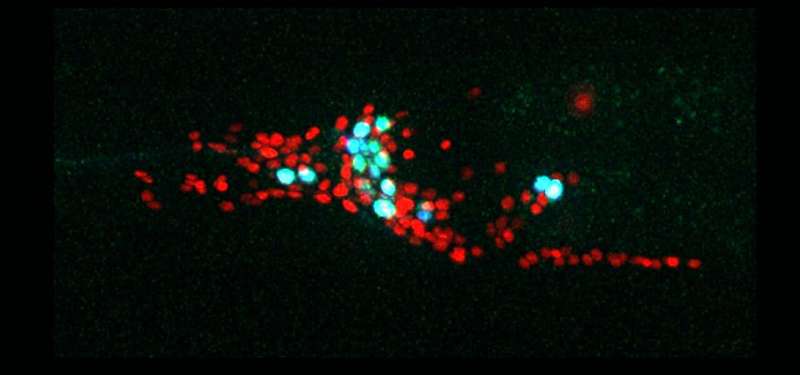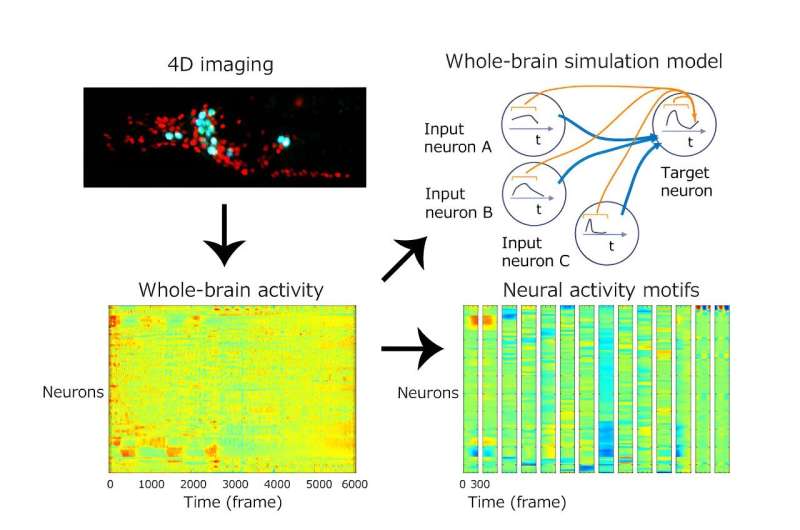This article has been reviewed according to Science X's editorial process and policies. Editors have highlighted the following attributes while ensuring the content's credibility:
fact-checked
peer-reviewed publication
trusted source
proofread
Scientists demonstrate how individual differences in 'whole-brain' activity are generated in roundworms

Joint research led by Yu Toyoshima and Yuichi Iino of the University of Tokyo has demonstrated individual differences in, and successfully extracted commonalities from, the whole-brain activity of roundworms. The researchers also found that computer simulations based on the whole-brain activity of roundworms more accurately reflect real-brain activity when they include so-called "noise," or probabilistic elements. The findings were published in the journal PLOS Computational Biology.
The roundworm Caenorhabditis elegans is a favorite among neuroscientists because its 302 neurons are completely mapped. This gives a fantastic opportunity to reveal their neural mechanism at a systems level. Thus far, scientists have been making progress in revealing the different states and patterns of each neuron and the assemblies they form. However, how these states and patterns are generated has been a less explored frontier.
First, the team of scientists measured the neural activity of each cell that makes up a primitive brain in the roundworms' head area. To achieve this, the worms were placed in a microfluidic chip, a tiny device designed for worms to be able to "wiggle" backward and forward while keeping them within the field of view of the objective lens. Then, using a confocal microscope, the scientists filmed how the neurons reacted to changes in salt concentrations.
"Although we were able to extract neural 'motifs' common among individuals," Iino says, "we were surprised to find large individual differences in neural activity. Information from sensory neurons is transmitted to 'command' neurons through multiple paths to control behavior.
"Since the neural circuits of C. elegans are thought to be relatively well conserved among individuals, we had assumed that there would be little variation in these paths among individuals. But remarkably, we found the opposite."
The data derived from these "films" of roundworm brains were then used to create computer simulations of roundworm brains. However, the first simulations that contained only deterministic elements generated decaying "neural" activity. By adding "noise" to the models, the team achieved an accurate representation of the roundworms' whole-brain activity.
The scientists were not only able to estimate the strength of connectivity between neurons but also demonstrated that "noise" is essential to brain activity. This mathematical model could even potentially be applied to analyze neuronal activity in cases where complete connectome data is not yet available.
With such possibilities, the number of exciting, new questions seems infinite. But a scientist must choose.

"We originally designed this study to investigate the neural mechanisms involved when roundworms are attracted to salt," Iino explains.
"However, to measure whole-brain activity, we needed to keep the roundworms in a narrow channel so that they would not move away. We would like to improve the microscope so that we can track freely moving roundworms and analyze whole-brain activity while they are being attracted to salt."
More information: Ensemble dynamics and information flow deduction from whole-brain imaging data, PLoS Computational Biology (2024). DOI: 10.1371/journal.pcbi.1011848





















